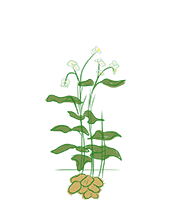
The potato is native to the Peruvian-Bolivian Andes and is one of the world’s main food crops. Potatoes are thought to have been independently domesticated several times and were largely cultivated in South America by the Incas as early as 1800 years ago. Encountered by the invading Spaniards, potatoes were introduced into Europe during the second half of the 16th century. By the end of the 17th century the plant was a major crop in Ireland, and by the end of the 18th century it was a major crop in continental Europe, particularly Germany, and in the west of England. It continued to spread, in both Western and Eastern hemispheres, during the first four decades of the 19th century, and the Irish economy itself became dependent upon the potato. However, the disastrous failures of the Irish crops in the mid-19th century (especially in 1846 and 1848), because of late blight (Phytophthora infestans), and the resulting Irish Potato Famine generated a more-cautious attitude toward dependence on the plant. Until the early 1990s, most potatoes were grown and consumed in Europe, North America, and countries of the former Soviet Union. Since then, there has been a dramatic increase in potato production and demand in Asia, Africa, and Latin America. China is now the biggest potato producer, and almost a third of all potatoes is harvested in China and India.
Potato (Solanum tuberosum) is an herbaceous perennial plant in the family Solanaceae, which is grown for its starchy edible tubers. The potato plant has a branched stem and alternately arranged leaves consisting of leaflets which are both of unequal size and shape. The leaflets can be oval to oblong in shape. The potato plant produces white or blue flowers and yellow-green fruits which are small poisonous berries with numerous seeds. The stems extend underground into structures called stolons. The ends of the stolons may enlarge greatly to form a few to more than 20 tubers of variable shape and size, usually ranging in weight up to 300 grams (10 ounces). The potato tubers grow underground and generally located in the top 25 cm (10 in) of the soil. The tubers can range in color from yellow to red or purple depending on the variety. The tubers bear spirally arranged buds (eyes). The buds sprout to form clones of the parent plant, allowing growers to vegetatively propagated potato plants for next season. Potato plants can reach more than 1 m (3.3 ft) in height.
Solanum tuberosum is a perennial but is grown as an annual crop. The optimum temperature for growth is 21°C, and growth is restricted below 7°C and above 30°C. Tuber formation in is favored by short days. It is also essential to have ample soil moisture for optimum yields. Deep, well-drained sandy or silt loam soils are ideal for growing potato, with a soil pH between 5.5 to over 7.5. Potatoes are mainly propagated by vegetative methods (cloning). Potato tubers have nodes or eyes from which the new growth begins. The new stems growing from each eye are called sprouts which gives rise to the new plant. Vegetative seed can be either a whole tuber or a cut tuber. In general, seed potatoes should have an average weight of 60 g, with most seed potatoes weighing between 35 and 85 g. Seeding rate will vary depending on the intended end-use, but typically ranges from less than one to more than six tonnes per hectare. Ideal soil temperatures for planting are 13-16°C, but should generally be at least 8-10°C. Along each row of plants, the soil is ridged up, a process known as hilling, to prevent exposure of the developing tubers to light. Tubers produce the alkaloid solanine and turn green when exposed to light, which renders them unfit for human or livestock consumption. For the same reason, tubers should be stored in a dark place after harvest.
Potato withdraws a lot of nutrients from the soil, and fertilization with applications of nitrogen, phosphorous and potassium is generally required to ensure adequate plant growth, tuber yield and quality.
Of all the essential elements, Nitrogen (N) is the one most often limiting for potato growth, particularly on soils with low organic matter. Ensuring adequate N is necessary to achieve high yields. Nitrogen is required to obtain both good quantitative and qualitative results. It is recommended to bring 40% of the total nitrogen under organic form at seedling stage and a further covering soil application at later stage.
Phosphorus (P) is important in enhancing early crop growth and promoting tuber maturity. The Phosphorous which favors the resistance to coldness and the content of starch is requested at the very first stage of the potato development and more specifically in an organic form to avoid any insolubility issues.
Potatoes take up significant quantities of Potassium (K), a nutrient that plays important roles in tuber yield, size, and quality. The plant needs high K to attain good storage quality.
It is always better to use organic fertilizers because bringing organic matter and humic acids favor the development and the health of the plants. It also helps to improve poor soils and to avoid excess of salinity in the soil, which is the main problem with chemical fertilizers.
Micronutrients are essential for a good quality and quantity of the production. Among these, Zinc is generally required, and it is better to use biochelate form able to provide the element and at the same time boost plant metabolism thanks to the biostimulant action. Bringing Calcium is useful to improve the growth and formations of tubers, the firmness, and the shelf life.

Before plantation


Plantation






Tuber initiation




Tuber formation




Full flowering




The roots of a plant have several important functions. The roots anchor the plant in place, resisting the forces of wind and running water or mud flow. The root system takes in oxygen, water and nutrients from the soil, to move them up through the plant to the stems, leaves and blooms. Roots often store the energies created by the plant through photosynthesis, to make them available to the plant as it is needed. Plant roots also stimulate and support microorganisms in the soil that benefit plant life. Support root growth is essential especially just after the transplantation to favor a rapid restart of vegetative growth of the crop and reduce transplant shock. Natural Lateral Root Promoting Peptide (LRPP) is a pool of peptides that improves lateral rooting and plant development. It is a plant biostimulant molecule which has been isolated after several years of R&D collaboration by HELLO NATURE and universities.
Agricultural soil is a fundamental component of the agricultural ecosystem. The most widely recognized function of soil is its support for food production. It is the foundation for agriculture and the medium in which nearly all food-producing plants grow. Healthy soils supply the essential nutrients, water, oxygen and root support that our food-producing plants need to grow and flourish. Soils also serve as a buffer to protect delicate plant roots from drastic fluctuations in temperature. Furthermore, the soil also performs hidden and less evident functions called ecosystem services. Careful soil management is one essential element of sustainable agriculture and provides a valuable lever for climate regulation and a pathway for safeguarding ecosystem services and biodiversity. Hello Nature propose an integrated approach to keep agricultural soil alive and healthy applying sustainable solutions: organic fertilizers, vegetal derived plant biostimulants and beneficial microbials. These solutions act on two of the main indicators of soil health, organic matter and biodiversity.
Microelements like copper (Cu), manganese (Mn), Iron (Fe), and Zinc are absorbed by plants in reduced quantities, but they are nevertheless essential to achieve adequate levels of quantity and quality of agricultural production. Lack of micronutrients in the soils is very common and their availability can be disrupted by antagonistic relationships between soil nutrients, or soil pH. Micronutrient deficiency can strongly affect crop productivity. Providing micronutrients is the solution to allow the expression of the maximum productive potential of the crops. Micronutrients biochelated to vegetal peptides is an innovative solution to provide the elements to the crop. Our exclusive bio-chelation technology can strongly bi0chelate the nutrient and the vegetal peptides perform a biostimulant action increasing tolerance of corn to abiotic stress.
Nowadays, sustainable fertilization management is essential to increase the overall performance of cropping systems by providing economically optimum nourishment to the crop while minimizing nutrient losses from the field and supporting agricultural system sustainability by increasing Nutrient Use Efficiency (NUE). NUE is directly linked to the crop yield and generally defined as the yield of harvestable product per unit of nutrient available from the soil and fertilizer. Our vegetal peptides, which we called Plant Stimulating peptides, improves NUE by enhancing both the uptake and utilization efficiency of nutrients. For instance, promoting the fine root growth, stimulating root enzymes involved in nutrient uptake, or upregulating genes encoding for enzymes involved in plant assimilation of inorganic nutrients such as nitrates.
All growers, conventional and organic, have an interest in gaining back the yield potential lost due to abiotic stresses. It’s proven that on the average, farmers can harvest only 50% of the yield potential. The yield gap can be caused by biotic and abiotic stresses with a stronger negative impact of abiotic stresses. In fact, abiotic stresses like heat, cold, salt, drought and flooding caused from 65 to 75% of the yield gap, while biotic stress only 25 to 35%. Our vegetal protein hydrolysates, containing Plant Stimulating Peptides (PSP) have been shown to consistently help plants better recover from stress events also after herbicide application by increasing antioxidant supply, stimulating antioxidant biosynthesis, and activating antioxidant defense enzymes. PSPs maintained higher photosynthetic activity and a better nutritional status in the shoot tissues leading to a higher crop performance.
Marketable yield in potato is strongly directed to the number of tubers, their size and uniformity. For this reason, it is important to apply specific products with biostimulant action able to boost plant metabolism and achieve better crop performance. Our vegetal protein hydrolysates, contanining Plant Stimulating Peptides (PSP) act energically on plant development thanks to the combined presence of organic nitrogen and peptides of 100% vegetal origin. They are rapidly absorbed by leaves and translocated in plant tissues, so that within few hours, they can perform their positive actions. Our vegetal protein hydrolysates applied at Tuber formation have been shown to increase the number of tubers, while a second application at full flowering can improve the yield by increasing and standardizing tuber size.







